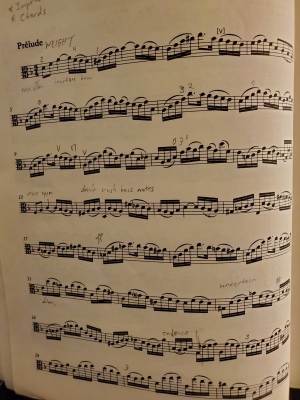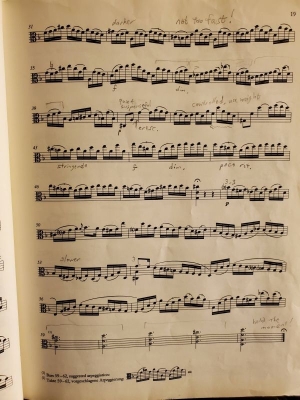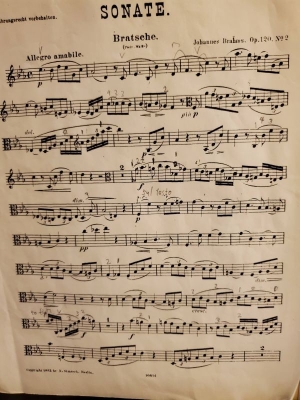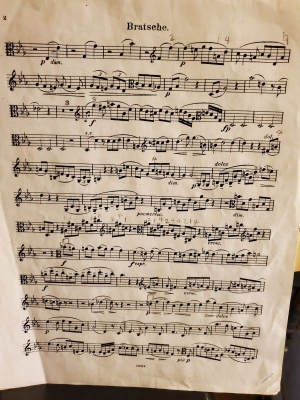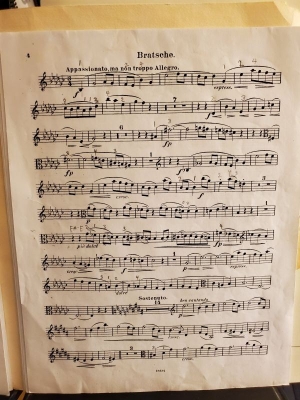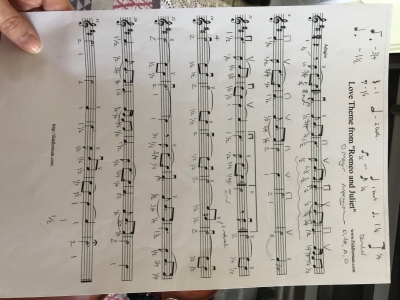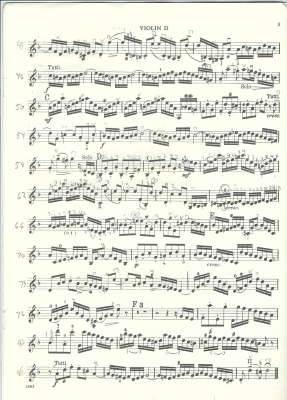Welcome to our forum. A Message To Our New and Prospective Members . Check out our Forum Rules. Lets keep this forum an enjoyable place to visit.
Currently working on errors from the latest (SimplePress) forum update. Many issues have been resoled and others are being worked on. Thank you for your patience.
 Topic RSS
Topic RSS



 (0 votes)
(0 votes) Regulars
 Offline
Offline



Regulars







It's always going to look like that no matter how good you get. I have a lot of pencil markings in most of my sheet music. Fewer fingerings, but my orchestra music often has beats written in, and there are bowings and a lot of reminders on expression everywhere. My orchestra music only looks a bit cleaner because there's a lot of common part-marking shorthand I've picked up, such as a pair of glasses meaning "tempo may change, watch the conductor."
I'm not home at the moment, but I think I'm going to post my copy of the Prelude from Bach Cello Suite No. 2 when I can. You can also take a look at some of my pictures of marked orchestra parts in my blog thread.
Regulars
 Offline
Offline



@AndrewH
I read your blog and looked at your music notations. Some of it I have no idea what it means. Some of the score is beyond my musical understanding at present too.
At least I know that I'm not too far out in the weeds with my own efforts and that I'll eventually improve beyond what I absolutely need now in order to play. Whether it will ever rise to your level is another thing altogether.
Regulars







I looked back, and apparently I didn't post as many pages of marked parts as I thought I did. But I think the best example in there is the May 8 post, where you can see penciled-in vertical lines marking beats in the music, other stuff to help with rhythm (e.g. numbers of 16th notes between each note, numbers of repetitions), fingerings, up and down arrows for non-obvious shifts, and an enharmonic ("=A#" below a B-flat so the interval from the earlier sharps would be clearer).
Here's what some of my solo music looks like, at different stages of learning pieces. The first two images are the Prelude from Bach Cello Suite No. 2; the next two are the first two pages of the first movement of the Brahms E-flat viola (clarinet) sonata; the last is the first page of the second movement of the same Brahms sonata. The Bach is what the page looks like when the piece is ready for performance. The Brahms has less markings, but that's mostly because I only recently started working on it.
Regulars
 Offline
Offline





I ruin mine. All my life I've been told to use pencil, but I can't resist using ink after a while and I feel confident. I guess psychologically it's my way of asserting myself and telling the music I own it, it doesn't own me. And then I have to use Tippex/Snopake when I change my mind, lol. It's a good reason to use IMSLP as much as possible, though. I'll post an example sometime. That's a pretty heavily edited Bach prelude, Andrew. Do you try to follow its phrasings and bowings? I'm not sure I would. I see to my surprise that my Wenzinger cello Baerenreiter is almost as heavily edited. I won't compare them in detail. I guess it depends on the editor - I'm used to Manze, who is sparser.
Andrew
Verified human - the ignominy!
Regulars







This is the less-edited of the two editions I have. This is the Simon Rowland-Jones edition; I also have the Watson Forbes edition. The bowings I actually use are mostly a mixture of the two. I didn't mark a lot of bowings in the Prelude because it's supposed to sound improvisational and I've tended to vary the bowings in the moment. I penciled in a lot more bowings in the other movements of this suite.
Regulars
 Offline
Offline



@Katie M
That piece is gorgeous to play. I have it as part of my regular repertoire and the more I play it the more I discover in it. For instance, the bowing beginning in Bar 15 is very interesting and the complexity of it keeps me from memorizing the piece.
Some day I might even be able to play it decently.
Regulars
 Offline
Offline



Katie M said
It really is. The string crossing at the beginning I’m finding really difficult.. from the c# to the f# it’s not a quick wrist one but not a whole arm one it’s somewhere in between ..
I bridge the C# and F# with my second finger and rock it from the A to D string as I reverse the bow stroke to play the F# on D2. It's simple - push (up bow) for the three note slur, rock the finger and change strings, pull (down bow). The bow follows the fingers since they're both rotating in the same direction.
Regulars
 Offline
Offline



Katie M said
I really like the sound of this RDP i’m struggling to practice it maybe my fingers are a bit small.. hmm can’t really change that !! I will keep practicing thank you for the tip hope your R&J is going well.
I would practice the transition from A2 to D2 by centering your fingertip between the strings and rocking while doing the string crossing. It doesn't take much to stop the string.
R&J? Ribs & Jalapenos? Ripcords and Jeronimos? Romances and Ju Ju Bees? Wait, romances... hmmm.
Oh, I know, Romeo and Juliet! Hah! You can't fool me (well, most of the time you can). By the way, the actual name of that piece is "A Time For Us."
Regulars
 Offline
Offline



SharonC said
@RDP I draw all over mine. Might erase some of it later, if it seems to obscure the “big picture”of things after I’ve learned it.
Ummmm, I'm nowhere near that kind of playing ability so you can make whatever marks on that score you want to and I'm perfectly ok with it. 
At least now I know I'm not totally weird for marking my sheet music. My handwriting isn't as neat as you guys, I'm kinda sloppy in comparison, but I'm in good company with the rest of it.
Regulars
 Offline
Offline



Yep, sounds normal to mark sheet music all over :--)
Most of the time I play without sheet music – or without looking at it once I have the notes in memory – but I guess I should do it. Meaning, really think about the best ways (for me) to play each passage.
I tried to, at some point, but couldn't decide between fingerings etc… and ended up erasing and changing a lot of it, so now it sounds like a lot of work "for nothing".
Regulars
 Offline
Offline





If I'm lucky enough to attract @Fiddlerman's attention, while Sharon has that Bach double posted up there, I'll be starting it (again) in 6 or 7 weeks' time, and I notice that Sharon hasn't marked those minims (half notes).
There are two schools of thought: - Manze downbows them all, and presumably climbs his way back towards the frog on alternate 16th notes. I hate that.
Then there's the older way (Oistrakh's Peters edition?) where you alternate one minim downbow and the next upbow. For that, I'm guessing you end up in the middle of the bow playing some of it spiccato (as opposed to playing all the 16th notes at the tip of the bow)? Is that a good guess? If it is, that's the way I choose. If not, then I'm clueless.
Andrew
Verified human - the ignominy!
Regulars
 Offline
Offline





Fiddlerman said
Gordon Shumway said
If I'm lucky enough to attract @Fiddlerman's attention, while Sharon has that Bach double posted up there.........
lol, I'm sorry every time I miss someones post. I don't do it intentionally. Also, I don't reply often enough to all you great people who share your work. Thanks everyone!!!
I was asking you how to bow the Bach, Pierre! Maybe I'm not direct enough.


Andrew
Verified human - the ignominy!
1 Guest(s)


 Log In
Log In Register
Register





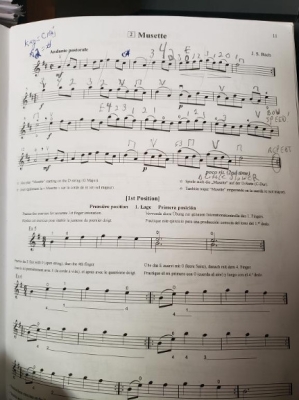

 Online
Online





